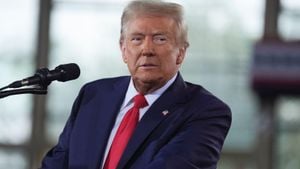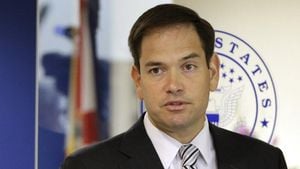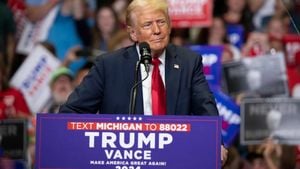Donald J. Trump’s recent return to the political spotlight as president-elect has sparked intense debate across the political spectrum. Known for his unpredictable style, Trump’s first week unveiled cabinet appointments filled with loyalists, creating ripples of both excitement and concern within Washington. From selections deemed unconventional to traditional ally picks, Trump’s choices have become the focal point of analysis as allies and opponents alike gauge the direction of his upcoming administration.
During this week, Trump moved quickly to fill his administrative ranks, naming key figures who align closely with his previous policy initiatives and stylistic inclinations. One prominent selection was Matt Gaetz, the controversial Congressman from Florida, who was nominated as Trump’s pick for Attorney General. Gaetz is known for his staunch loyalty to Trump and is seen as someone who can help the administration navigate legal challenges and push back against investigations. His nomination, though embraced by Trump's core supporters, raised eyebrows among Republicans who worry about his lengthy history of controversies.
Meanwhile, the Senate also made headlines this week as it pondered the leadership of John Thune, who is poised to become the next Senate Majority Leader. Thune’s leadership style is expected to both support and complicate Trump's ambitious agenda. While Thune is seen as traditional and pragmatic, his alignment with the broader Republican base will play a significant role as the Senate contemplates the paths it will take under Trump's leadership.
Perhaps one of the more talked-about instances was the brief public display of civility between President Biden and Trump when they coincidentally crossed paths at the White House. Following somewhat of a public reconciliation, the two men engaged in discussions for over two hours behind closed doors. Observers noted the meeting’s significance, with both leaders addressing key issues facing the nation, which are likely to set the tone for the next several months.”
Adding to this mixed bag of appointments was Trump’s nomination of Fox News host Pete Hegseth for Secretary of Defense. This step has left many Republican legislators scratching their heads, with some phraseology indicating outright disbelief. Hegseth, who lacks significant management experience relative to the enormity of the Defense Department, is regarded by critics as someone whose media presence does not necessarily translate to effective governance. Despite his military background as a decorated Army veteran, doubts were immediately expressed about his qualifications to helm the Pentagon.
A member of the Republican Senate even shared their incredulity with Rolling Stone, stating, “That makes no sense!” Similarly, Senator Lisa Murkowski was heard exclaiming “Wow” when asked about Hegseth’s nomination, reflecting the hesitation circulating among GOP ranks. Trump’s affection for Hegseth and his media persona, showcased through previous recommendations for various positions, underscored the capricious nature of Trump’s leadership appointments.
But Trump’s appointments didn’t just evoke doubts; they also served to rally his core base. Supporters embraced the idea of refreshing the establishment, with many singing praises for Hegseth's outspoken nature on issues like “wokeness” within the military. His rhetoric, which has included controversial views on race and “woke culture,” resonates with many who feel disenfranchised by the traditional political rhetoric.
Further enhancing his controversial image, Hegseth has been associated with far-right movements, raising alarms among those vigilant of extremist ideologies infiltrated within the military. His prior comments sympathetic to white nationalists and the tough stance he takes on diversity initiatives have put him at odds with mainstream Republican beliefs.
Another notable name included Biden’s former Chief of Staff, John Podesta, who expressed cautious optimism over Trump’s choices, indicating the necessity for bipartisanship moving forward. “We all have to work together,” Podesta articulated, echoing sentiments shared by several centrist figures concerned about the aggressive partisanship likely to accompany Trump’s appointments.
Yet, beyond these cabinet appointments, there exists another whole layer of tension revolving around the Republican Party itself. There are factions within the GOP who keep questioning their alignment with Trump’s aggressive stance and decisions, prompting conversations about the party’s future. The potential pushback from within the ranks raises questions about whether the GOP can remain unified, or whether it will fracture under the strain of Trump’s razor-thin margins.
Past legislative efforts, particularly concerning healthcare and immigration, are expected to remain contentious arenas. While Trump’s ambitious visions include aggressive maneuvers on immigration, many within the party are wary of alienation—brought on by Trump's notoriously harsh policies. This could prove detrimental, as the party seeks to establish its footing for the 2026 midterm elections.
Adding even more fireworks to the political scene is the possible backlash when gauged against the public’s opinion. Recent polls suggest discontent among voters concerned with radical approaches. With many constituents holding mixed opinions toward immigration reform and foreign policy, the upcoming administration faces the Herculean task of appeasing both the far-right and moderate sections of their base.
Trump’s first week has not just been about new appointments; it has undoubtedly set the stage for battles to emerge. With potential recess appointments being floated around, Trump's ploy to sidestep opposition raises the stakes for his administration more than ever. While previously Trump had to negotiate with Senate Republicans, it's now becoming increasingly clear he might be angling for fewer obstacles standing between him and his preferred picks.
Despite the uncertainties within the party and Trump’s style of governance, there’s one thing that's clear: this new chapter of Trump’s presidency is unlikely to resemble anything seen before. The reactions to appointments, vibrant public debates, and palpable tensions point to months—if not years—of political theater both within the halls of Congress and beyond. Political analysts are already devising strategies to keep pace with Trump’s fast-moving agenda, one that's fraught with high risks and astronomical opportunities.
So what happens next? That’s the big question policymakers and constituents alike want answers to. With the rollercoaster ride of Trump’s first week ending, attendees are now digesting the aftershocks and bracing for the next installment of headlines. Political pundits remain split on how effective this hasty pace will be and just how many surprises are still left up his sleeve as he embarks on this extraordinary second act.



